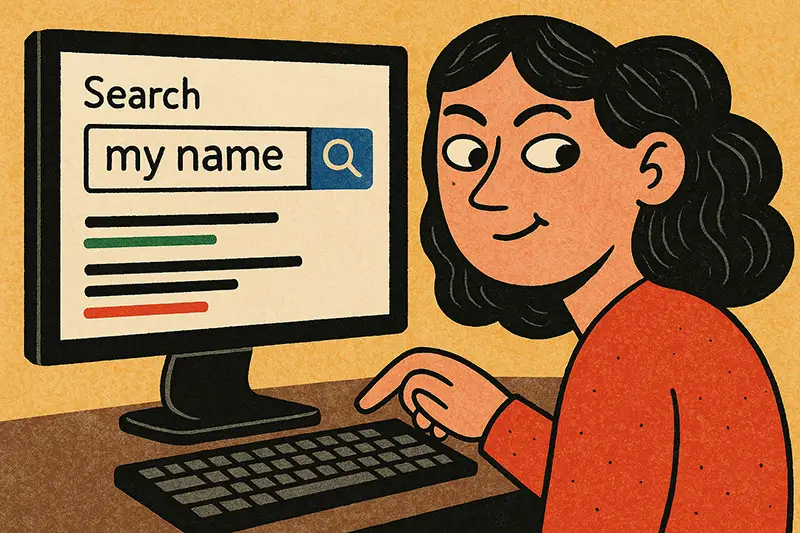Table of Contents
How I Search My Name & Why You Should Google Yourself As Well
Want to learn how I search my name online? Well, every once in a while, I Google myself not out of vanity, but out of awareness. It’s a quiet ritual, like holding up a mirror you didn’t design. What comes back isn’t a reflection of who I am, but who the internet thinks I am.

Sometimes it’s harmless, maybe an old project, a comment from years ago, or a social profile I barely remember creating. Other times, it’s jarring like a result that’s outdated, misleading, or aggravatingly permanent.
Searching your own name is a small act of self-inquiry in a time when algorithms archive everything. It’s not an ego thing; it’s about understanding what story your data tells when you’re not in the room.
1. What I See When I Search My Name
When I type my name into Google, the results come in layers — some I built, some built for me.
The top results are predictable: LinkedIn, a personal website, and a few social accounts. Then come the ghosts — mentions in directories, cached press releases, old bios from long-gone projects, and forum posts I forgot existed.
Scrolling down, I start to see the web’s version of context collapse. There’s no distinction between what’s professional, personal, or outdated. The algorithm doesn’t care what year it is, it just remembers things you’d rather forget.
Welcome to the strange reality of modern identity, where we exist in fragments, floating across platforms, stitched together by search engines with elephant memories.
At first, seeing yourself as metadata is uncomfortable. But over time, I realized this discomfort is helpful because it reminds me that digital presence is cumulative and not fixed. It’s the residue of attention.
2. What Digital Footprints Actually Mean
Every result tells a small truth.
Your LinkedIn might show what you want people to know. Your Instagram or old Twitter might show what you used to share. Public databases might reveal what you never meant to publish, such as your age, address, old contact info, and even legal cases.
Together, these fragments form your digital footprint — the trail of public data linked to your name, intentionally or not.
Most people assume that what appears on Google is random, but it’s actually weighted by visibility, authority, and repetition. The more your name appears on trusted sites, the more that version of you becomes “real” in search results.
That’s why a ten-year-old article can outrank your current website: the web never retires old content, it just archives it in plain sight.
According to the Pew Research Center, 67% of adults have searched for their own name online. Of those, more than half say they found results that surprised or worried them. Yet fewer than one in five take active steps to manage what’s visible.
That means most people are unaware of how their identity circulates online.
We live in a paradox: our data is everywhere, but our awareness of it is limited.
3. How I Search My Name Online & Manage My Reflection Without Obsession
There’s a fine line between awareness and anxiety, and it’s crucial to maintain that balance. After a few deep dives into my name search results, I learned that digital self-maintenance doesn’t have to become an obsession; it can be gentle, intentional, and even empowering.
Taking control of your digital presence can give you a sense of confidence and assurance.
Here’s how I search my name occasionally without panicking.
a. I start with a fresh search.
I log out of all accounts, clear cookies, or use an incognito window. That’s closer to how others see me online. I try variations of my name with and without middle initials, location, or profession. Sometimes what’s hidden from me is visible to everyone else.
b. I audit the first two pages.
Page one is your public face; page two is your shadow. I list what I find — what’s current, outdated, and strange. If I see something I’d rather not, I take a breath before reacting. Then I ask if it’s inaccurate, irrelevant, or just uncomfortable? If it’s incorrect, I contact the website to request removal. If it’s just uncomfortable, I let it go.
c. I claim what’s mine.
Owning your own name online is the simplest form of digital self-defense. By registering a personal domain, setting consistent handles across social media, and filling in bios with up-to-date info, you can take charge of your digital identity and ensure the most accurate version of you rises to the top of search results.
I registered my personal domain (even if it currently redirects to a portfolio), set consistent handles across social media, and filled in bios with up-to-date info. The goal is to let the most accurate version of me rise to the top of search results, not to erase old data.
d. I monitor ever so often
Every few months, I set a Google Alert for my name, not because I expect the worst, but because I like to know when my digital reflection shifts. The web is alive, and keeping an eye on it is part of digital hygiene.
e. I clean what I can.
Tools like DeleteMe or manual opt-outs from data brokers (Spokeo, Whitepages, MyLife) help remove sensitive listings. But I don’t chase perfection. The internet is porous, and my goal is balance, not invisibility.
4. The Psychology of Seeing Yourself Online
There’s something quietly humbling about seeing your name on a results page. It’s proof that you exist in searchable, sortable, and persistent data form. But it’s also a reminder that the internet’s version of you isn’t your whole story. Psychologists call this the “digital looking glass.” Just as a mirror reflects your image, your search results reflect your choices, habits, and associations — but slightly distorted.
You see yourself refracted through algorithms that don’t understand nuance or change.
When I see something I don’t like, such as an old photo or an outdated profile, I remind myself that it’s a past self, not a permanent one.
Approaching your digital footprint with curiosity, not fear, is a healthy ongoing experiment in self-awareness and a journey of discovery about your reputation in the digital world.
5. Reframing the Act of Searching
Searching your own name is often treated as vanity, but I see it as mindfulness. It’s a simple way to stay conscious of how technology interprets you. And in an era when so many decisions, such as hiring and dating, begin with a search bar, that awareness matters.
What you find when you Google yourself is data, as well as a story in progress. Although you can’t control every version of it, you can guide its direction. Each update, correction, and mindful share becomes part of your online biography.
6. How I Search My Name & What I Learned About Myself
The more I search my name, the less I worry about what others might see because the act itself — the curiosity to look — is what keeps me grounded.
I’ve learned that the web’s memory is imperfect, and so am I. That’s okay. My digital footprint is a map of growth, not a record of mistakes.
It reminds me that awareness is about being present, not trying to control everything. And in a noisy, searchable world, presence is its own kind of privacy.
Why This Matters
Our online identities have become proxy versions of ourselves — data silhouettes that move through databases, social feeds, and search indexes long after we log off.
To understand them is to understand how visibility works in the modern world. Learning how to search your name is way more than vanity metrics or reputation management. It’s a quiet way of reclaiming agency.
In the same way we clean our homes or back up our files, tending to our digital selves is a small act of stewardship and care for the parts of us that live online.
Tools will evolve, but awareness never goes out of date.
Search wisely, and remember that the goal is to see yourself clearly, not to dig your head in the sand and pretend that uncomfortable information about you does not exist online.
Sources
- Pew Research Center. “Americans’ Complicated Feelings About Online Privacy.” November 2023: Examines how people perceive the visibility of their personal data and their online control.
- The Guardian. “How to Clean Up Your Digital Footprint.” March 2024: Offers practical, non-technical advice on managing your name and data online.
Related reading on How I Search:







